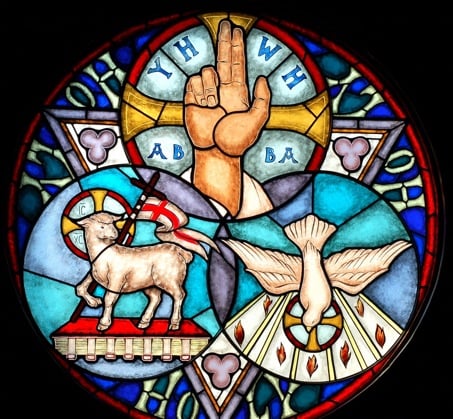The Crucifixion
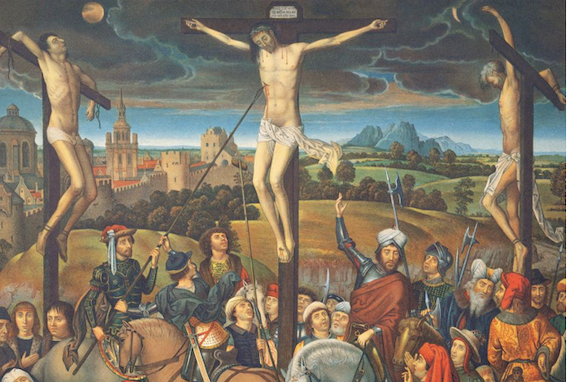
Introduction
After Jesus was given his crown, staff and robe, he was led to Golgotha to be crucified. Several pages on this site have already dealt with aspects of the Crucifixion, in particular The September-11 Crucifix. and The Sign of the Cross. This page continues the narrative unfolding from the numbers engraved on the Crown, or if you like, growing in the New Garden, since so many of them are trefoils ('three-leaved plants').
Trefoils are created by performing one iteration (step) of the Koch antisnowflake process on a triangle. Fractal snowflakes, antisnowflakes and related figures are also created by one or more iterations of the Koch process and are studded throughout the text. They are the authentiating signature of God on His written Word, as this short video demonstrates.
Other geometric objects are found in the New Garden, including the cross shape itself. This is not a fractal but it unfolds from fractal geometry, the geometry in fact of the jewel itself. But first those figures have to be 'raised up' a dimension.
The Crown
We begin with the crown of thorns in the New Garden. I've shown it with the two logos stars encoded either side of it.
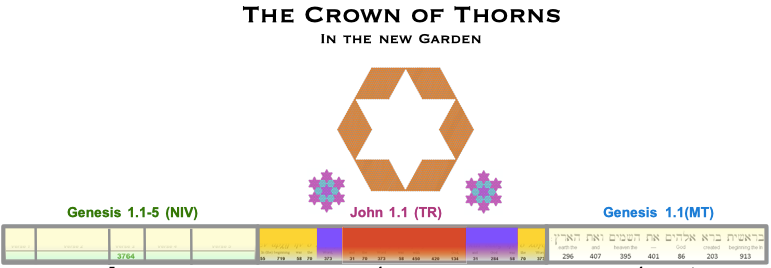
The Jewel
Star 1441, the jewel in the crown itself, is encoded in the NIV section of the New Garden of Eden. Here are both figures.

Here now is the jewel in its setting. I've shown the New Garden bent into a circle to create a diadem.
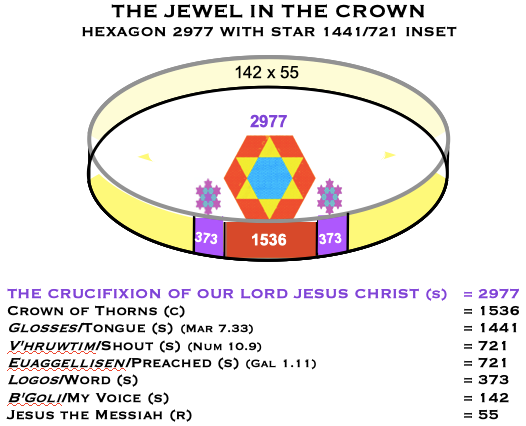
Star 1441 represents Jesus as the tongue of God, which fills crown 1536 to create hexagon 2977. Note that the rest of the diadem sums to 142 x 55, both numbers created (as their product, 7810) by joining the ends of the Garden and both again pointing to Jesus Christ and the Word of God.
142 is the antisnowflake equivalent of snowflake 373, both of these figures derived from triangle 253. Together they create a stunning trio, displaying and created by the Word of God.
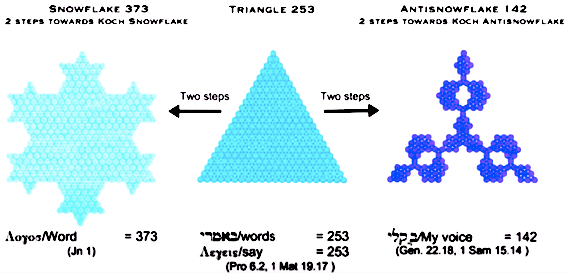
I have shown only two of the Biblical words related to verbal comunication that sum to 253, but there are several more. This video reveals more of these wonders.
55 is itself a fractal antisnowflake and also a triangle that self-reflects to form Star of David 73/37.
Preaching the Word
The central part of the jewel, symbolising the preaching of the Word, is hexagon 721. This is the smallest hexagon that will completely encircle the Logos Star, encoded either side of it in the text, as we have seen. The Logos Star holds within itself further symbols of Jesus as the Risen Lord, preaching the Word.
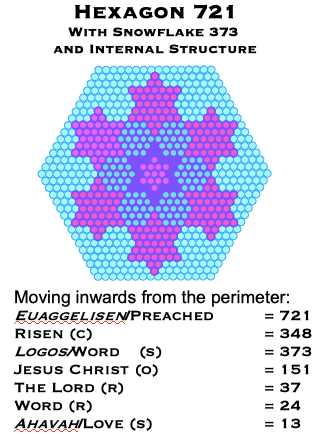
Hexagon 721 is a two-dimensional figure, essentially the simplest Koch snowflake, but it is also the projection onto a surface of a cube along its longest diagonal:
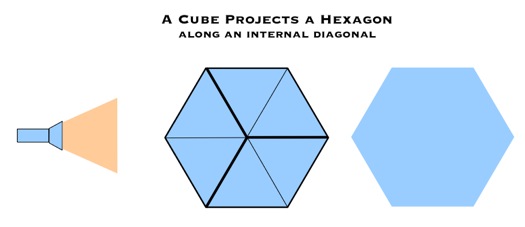
Hexagon 721 is projected by the cube of 16, made from 4096 spheres. This has a superficial surface area of 1536 sq. units.
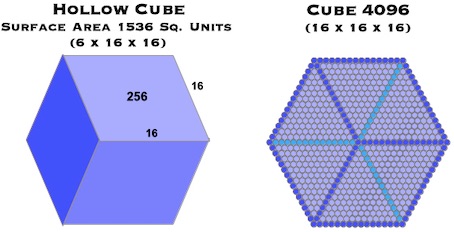
1536 is of course the numerical weight of the very word string we are focusing on, the central word string in John 1.1!
"and the word was with God" (Gr., s) = 1536
Here again is the crown of 1536 units in the central clause of John 1.1 (TR), bookended by the pair of logos stars encoded either side of it.
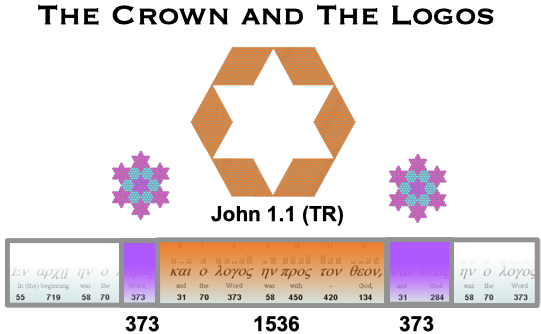
The Crown and the Cross
The number 1536 is associated with the figure of a cross as well as a crown, as I now demonstrate.
Firstly, a hollow cube (imagine it made of paper) can open out to reveal a cross [1].
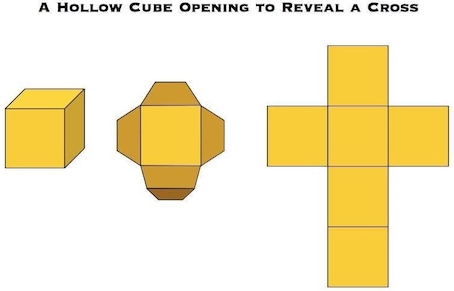
The area of the cross unfolding from a hollow cube with volume 4096 cubic units is 1536 square units, because 1536 = 6 x 256, which is a square. Six squares make a regular cross, as shown above.
4096 is not only a cube. In hyperdimensional geometry it is the tesseract (4D cube) of eight. A hollow tesseract unfolds into 3D space to form a 3D cross and for the tesseract of eight the 3D cross has 4096 counters. An orthogonal projection of this 3D cross displays a 2D cross of 1536 units. This gives us two ways of relating the number 1536 to the cross.
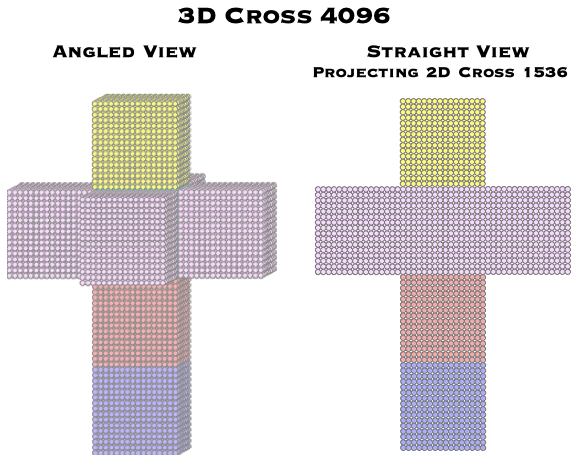
There is one more cross we can derive from cube 4096.
Shelling the Cube
If we remove all the internal spheres in cube 4096 (imagine removing a nut from its shell), we now create a cubic shell one unit thick with 1352 spheres:
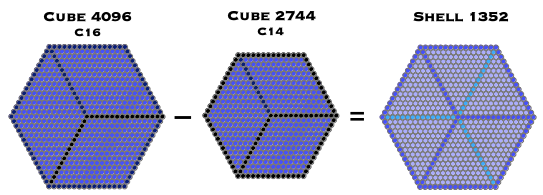
1352 is the standard value of these words:
The Crucifixion (s) = 1352
Cubic shell 1352 can also open out to reveal a cross, unfolding in a way similar to a paper cube. Now have three crosses derived from cube 4096, either as a solid cube or as 4096 spheres packed in cubic formation. All three crosses are shown here, with some very relevant identities. [1]
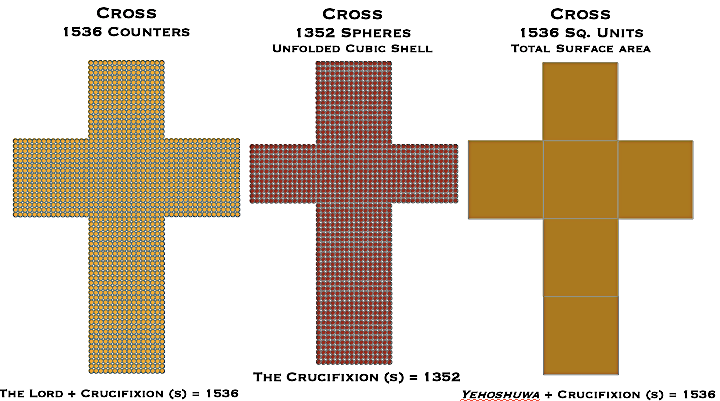
So, with a simple dimensional transformation we have three portrayals of the Crucifixion of Jesus in the New Garden! Or if you like, we have a depiction of Jesus and the two criminals crucified alongside him. The importance of the Crucifixion and its connection to 9/11 are further examined in The Sign of the Cross.
The 'raising up' of 2D hexagon 721 to 3D cube 4096 is a model of the transformation from our 4D realm (three of space, one of time) to the 5D realm of heaven, as outlined in Jesus' Garment.
In summary:
Cross 1. In plane/solid geometry, a solid cube of 4096 cubic units has a superficial surface area of 1536 square units, so a hollow cube of this volume unfolds to form a 2D cross.
Cross 2. In numerical geometry, cube 4096 has an outer shell of 1352 units, which also unfolds to form a cross.
Cross 3. In hyperdimensioal geometry, tesseract 4096 unfolds into 3D to form 3D cross 4096, which projects a 2D cross of 1536 units. [2]
As always we see encodings that both reflect and enrich the Bible's plain text words.
The Skull
Jesus was crucified at Golgotha, which the gospels tell us was also known as 'the Skull' or 'The Place of the Skull'. Here are the four mentions, one from each gospel.
| They came to a place called Golgotha (which means The Place of the Skull). (577) |
| Matt 27.33 |
| They brought Jesus to the place called Golgotha (which means The Place of the Skull). (752) |
| Mark 15.22 |
| When they came to the place called the Skull, there they crucified him, along with the criminals - one on his right, the other on his left. 1210 |
| Luke 23.33 |
| Carrying his own cross, he went out to the place of the Skull (which in Aramaic is called Golgotha). 892 |
| John 19.17 |
The sum of the four chapter and verse indicators, read as numbers, has an interesting factor.
2733 + 1522 + 2333 + 1917 = 8505 = 567 x 15
567 is the combined value of the word 'skull'.
Skull (c) = 567
Even more impressively, 567 is the sum of the first thirteen words of the NIV Bible, which of course is the very 'head' of the New Garden, and is the standard value of 'thirteen' and the combined value of 'love'. There's an important triple link here, because the value of the Hebrew word ahavah/love is 13 and of course 567 is encoded over the first thirteen words of the NIV Bible.
| Skull (c) | = 567 |
| Thirteen (s) | = 567 |
| Love (c) | = 567 |
| Ahavah/love (s) | = 13 |
This is a direct reference to the fundamental meaning of the Crucifixion, encapsulated in the phrase "Christ's Passion", which happened at Golgotha, the Place of the Skull.
| Golgotha (s) | = 373 |
| Logos/Word (s) | = 373 |
| Passion (s) | = 390 |
| The Man (c) | = 390 |
| The Word (r) | = 39 |
'The Man' is the name Pilate called Jesus just before he was led to the Cross: "See the man!" (John 19.5)
The Geometry of the Skull
Fractal geometry is the principal source of the numbers used to weave the New Bible Code together. Nearly all of the geometry comes from applying the Koch snowflake process to numerical triangles, especially G-triangles. The Hebrew Bible's opening verse, Genesis 1.1 (BHS), the most important and inspired words ever written, contain what I now call the Fractal Generator (and Genesis is the book of generations!), which shows the first step in the iterative process leading to Koch snowflakes and antisnowflakes. This is shown in The Number of the Beast and in my video The Mark of the Beast.
Another type of fractal is the Sierpinski triangle, already featured in The Lock and the Key. The number 567 (Skull (c)), is the third iteration of a Sierpinski triangle, beginning with triangle 1176.
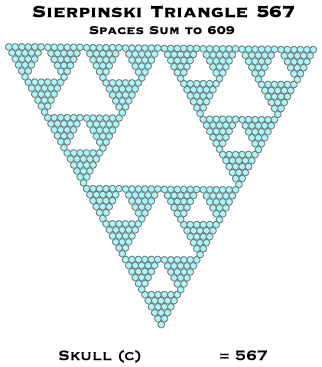
The triangle even looks something like a skull!
The skull was cut from triangle 1176, the standard value of these phrases:
| monogenes hulos/only begotten son (s) | = 1176 |
| The Cornerstone (c) | = 1176 |
1176 is also the 48th triangular number (T48):
Son (o) = 48
Both 567 and 1176 are encoded together at the very apex of the NIV Bible, sitting together at the top of scripture in reflection of the Cross, standing on the hill outside Jerusalem.

The Crucifixion in the New Garden
In fact the geometry of Jesus' Crucifixion, as delineated above, is found in a tight cluster in the same place, which remember is the NIV portion of the New Garden.
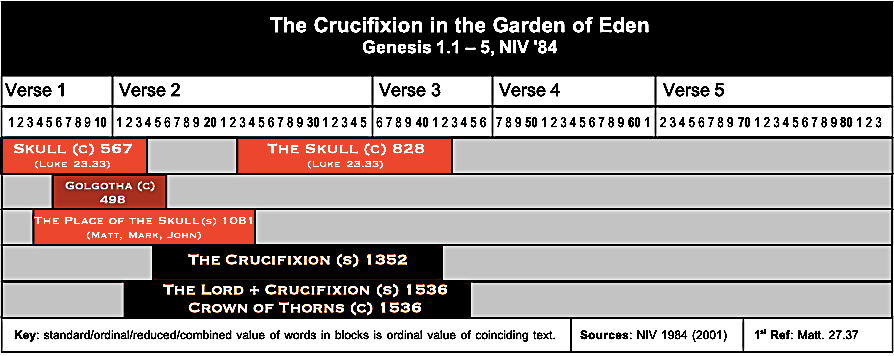
The improbable clustering of values for these meaningfully-related phrases, near the very beginning of the NIV, reflects the supreme import of the event.
Note that the standard value of 'the Place of the Skull' is 1081. 1081 is also found in John's portion of the Garden, again right next to 1536 (Crown of Thorns), as this next diagram shows. I've shown the New Garden as a band again (or if you like a long, thin strip of land!). [3]

So we have 1081 representing the Place of the Skull. This was a hill, also symbolised by 1081, since it is the 46th triangle.1352 and 1536 representing Jesus' Crucifixion and his Crown of Thorns. The three crosses visually symbolise the three crucified men.
Here are the principal geometric symbols arising from the numbers encoded within the New Garden, bent round again into a crown. [4]
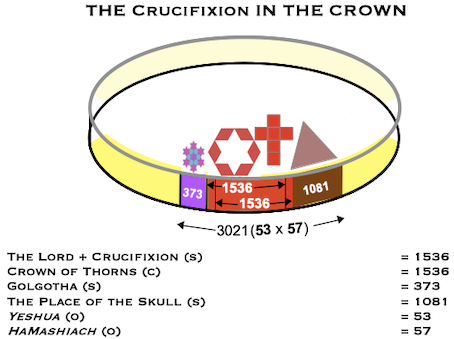
Note that 'Golgotha' and 'Logos' both have standard values of 373. 'The Place of the Skull', the name given in John 19.17 for the Aramaic word transliterated as 'Golgotha'. The title 'The Place of the Skull' has a standard value of 1081, which gives us a triangle to symbolise that hill and is also the generating triangle for the Jewel in the Crown!
Finally, I also show the full sum of the coloured section at the front of the crown. This is the product of the ordinal values of 'Jesus' and 'the Messiah' in Hebrew!
Here then is the full Crown of Thorns, fashioned in three sections from the most important verses in scripture in three languages, shown underneath as the New Garden. The thorns are the fractal snowflakes encoded within the Rhema issuing from the Messiah and, as displayed here in all their glory, within His Mighty Word. [5]
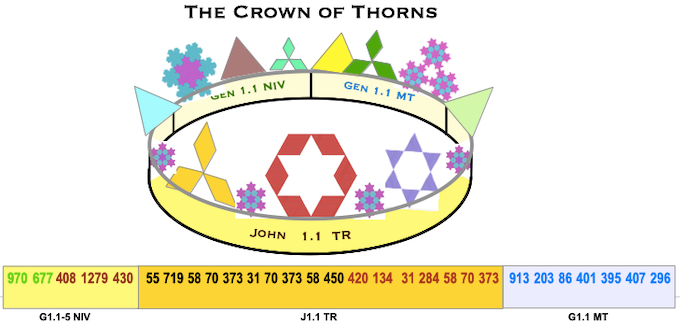
Bill Downie 22/11/22
Notes
1. This is one of eleven 'nets', which means different ways that a 2D cross can unfold, although it is possibly the most symmetrical unfolding. The equivalent cross in 3D, made famous by Dali's Crucifxion (Corpus Hypercubus), is one of 261 nets that a hollow tesseract will open out to form and again this is a particularly symmetrical unfolding. 261 is also the difference between the first and second groups of words in John 1.1: 1536 - 1275 = 261. Eleven is the central number in the New Bible Code and the reduced value of 'Jesus'.
2. Plane and solid geometry deal with plane surfaces and solid figures. Hyperdimensional geometry deals with higher dimensional spaces. Numerical geometry, has more than one meaning but is accepted as the study of digital or pixellated figures made from regular arrays of units, like the 15 balls arranged into a triangle on a pool table (expressing 15 as a triangular number). Unlike plane geometry, numerical geometry deals only with whole numbers, which creates fascinating and possibly largely unexplored limitations in how these figures are rendered - and also opens the door to gematria.
We are meant to see the Bible as a garden of delights, filled with fractal foliage, crystals and stars in the heavens. Pixellated images of fractals are only ever approximations ot these exotic figures, relatively new to mathematics. But this is exactly the same as in nature, where approximations of fractals abound, but where real fractals, like a perfect circle, will never be found. They exist only in mathematics. This is partly because matter is made of atoms, which can be likened to the small spheres I use to build cubes and pyramids. So pixellated figures serve as the ideal metaphor for our universe of form. We have perfection in that respect.
3. My own garden is just like that - and also has three parts!
4. The figure is closer to a diadem, which is defined in Ecosia as "a jewelled crown or headband worn as a symbol of sovereignty".
5. There are many more than I've shown here!
